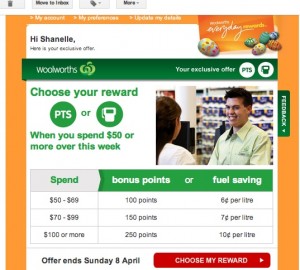Building loyalty and retention throughout your customer database is one of the primary uses for email marketing for businesses. Your customer database is often a businesses most valuable asset, but these people are even more valuable if their details are up to date and they are active customers. Active means that they are currently engaging with your email marketing (opening, clicking and taking action when asked) and your brand.
If you live in Australia, it is likely you do your grocery shopping at either Coles or Woolworths supermarkets and if you do, you may have chosen to sign up to their rewards programs – Everyday Rewards for Woolworths and Fly-Buys for Coles. These big businesses use these reward cards to gather initimate information about their customers. If you’ve signed up online for one of these cards you’ll be surprised at how much household financial information they ask for. They then get all of your shopping habbits – the time of day you prefer to shop, the day of the week you prefer to shop, where by live and work by where you buy your petrol or food and of course the type of food you buy which tells them how many people are in your house, how much you spend on average per week and your personal health. These cards and the petrol vouchers and email marketing coupons are designed to incentivise the customer to tell the business more about themselves. If I’m going to give away my personal information, I damn sure expect the reward to work!
For overseas readers, Coles and Woolworths supermarkets have a joint venture business with two of Australia’s largest petrol station chains – Coles has teamed up with Shell petrol service stations and Woolworths has paired with Caltex petrol stations. If you shop at either Coles or Woolworths and spend over $30, you are rewarded with a coupon voucher at the bottom of your groceries receipt for $0.04 cents off your petrol when you buy it from their partner petrol stations.
Because technology is improving, Woolworths now claim to add the $0.04 cents off petrol coupon to your Everyday Rewards membership card. I say “claim to add” because in my experience this is often not happening.
Let me tell you my story.
I bought my groceries at Woolworths and when paying for my groceries, I presented my Everyday Rewards card, which was scanned and at the bottom of my receipt it said “Your $0.04 cents off petrol voucher has been added to your card”. Ok, everything is fine.
A couple of days later, I get an email to my inbox offering me $0.06 cents off my petrol when I spend $50 or more at the Caltex petrol station on petrol and food products – all I need to do is activate my offer (see example image).
So I activate the offer by clicking on the email and I get a message telling me that my offer is now activated and I have 7 days to use it.
On my way to work the next day I stop specifically at a Caltex petrol station to fill up my car with petrol and I go into the station to pay and hand over my card, telling the cashier that there should be a $0.06 off petrol voucher on there. He scans my card and apologises and says that there is no voucher.
When I relayed the story I have just told you, he cringed and said that he has had the same thing happen with many other customers. As a good faith gesture he offered to give me the same discount if I spent $5 in store but by this time I’m cranky and have had a very bad brand experience with Woolworths so I don’t want to give them any more of my money.
This story and example shows that despite the incredible advances in technology and our desire as marketers to offer our customers some value – it is better to ensure that the process is air tight before putting it out to market. Because now my 700+ monthly readers are all aware of how I feel scammed by Woolworths and I’ve also told several people verbally.
Email marketing is an incredible tool that allows us access to our customers, but we need to respect the medium and make sure that we are 100% confident in our product before we send out a message because if we get it wrong, as Woolworths have here, the long term impacts could be great.
Please, tell me your loyalty card/ email marketing coupon redemption rants. I’d love to hear them


Your discount vouchers are redeemed in the order they are accumulated.
So, if you accumulated the 4c voucher first it will redeem before the 6c voucher.
Thanks for the reply Chris. I didn’t know that but and that sounds reasonable, but in my case, there was no voucher on my card at all. The “activation” online, didn’t translate to the actual voucher being credited to my account/ card.